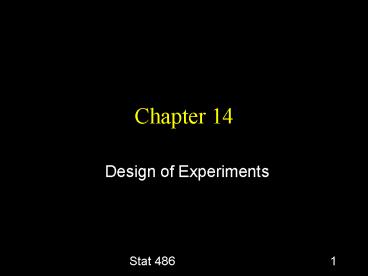Design of Experiments - PowerPoint PPT Presentation
1 / 18
Title:
Design of Experiments
Description:
Concerns experimentation to determine the relationship between ... Example: Acme Pinata Corp. 9 factors define a glue: Flour (white/whole wheat) Sifted (yes/no) ... – PowerPoint PPT presentation
Number of Views:52
Avg rating:3.0/5.0
Title: Design of Experiments
1
Chapter 14
- Design of Experiments
2
Introduction
- Concerns experimentation to determine the
relationship between manipulable factors and a
response of interest - Each combination of factors is a design point
- An individual response values with its factor
settings is a run - Want to minimize the number of runs while
maximizing what you learn
3
Experiment Designs
- Screening Designs which of many factors have the
greatest effect on the response. Factors settings
are usually binary (hi/lo on/off etc.) - Response Surface Designs which settings of a set
of continuous factors give the best response - Factorial Designs look at many combinations of
factor levels (chosen judiciously)
4
(No Transcript)
5
Example Acme Pinata Corp
- 9 factors define a glue
- Flour (white/whole wheat)
- Sifted (yes/no)
- Type (water/milk)
- Temp (cool/warm)
- Salt (yes/no)
- Liquid (4/5 teaspoons)
- Clamp (yes/no)
- Sugar (yes/no)
- Coat (thin/thick)
- Response strength of bond between two pieces of
paper
6
(No Transcript)
7
Main effects here are counfounded with 2-way
interactions
V
Analysis of the data must assume 2-way
interactions are all zero
8
SiftedYes ?(TypeW SaltYes) or (TypeM
SaltNo) SiftedNo ?(TypeW SaltNo) or
(TypeM SaltYes)
9
Fractional Fractorial Resolution
resolution 3 Main effects are not confounded
with other main effects. They are confounded with
one or more two-way interactions, which must be
assumed to be zero for the main effects to be
meaningful. resolution 4 Main effects are
not confounded with either other main effects or
two-factor interactions. However, two-factor
interactions can be confounded with other
two-factor interactions. resolution 5 There
is no confounding between main effects, between
two-factor interactions, or between main effects
and two-factor interactions.
10
Blocking for extraneous factors
e.g. suppose could only do 4 runs per day
11
Analysis of the Data
12
Screening for Interactions
- Optimizing operation of a nuclear plant
- Five factors
- Feed rate (10/15)
- Catalyst (1/2)
- Stir rate (100/120)
- Temperature (140/180)
- Concentrator (3/6)
- Response is reactor output
- Full Factorial design has 32 runs
13
JMP DOE Prepares the Model
Generates the correct Fit Model dialog for the
design
14
Interaction Profiles
15
Response Surface Designs
- Useful for modeling a curved surface as a
function of continuous factors - Curved usually means quadratic
- Need three levels of each factor to fit a
quadratic - Standard designs include central composite and
Box-Behnken
16
Central Composite
Box-Behnken
17
(No Transcript)
18
(No Transcript)































